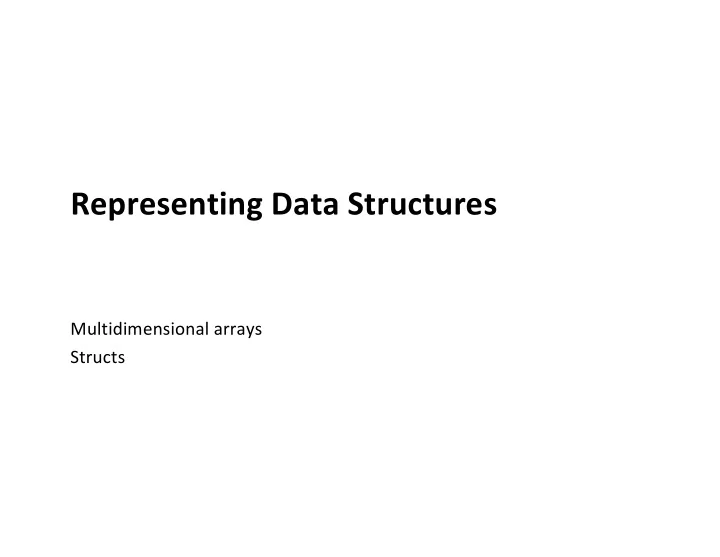

Representing Data Structures Multidimensional arrays Structs
Array Layout and Indexing int val[5]; +0 +4 +8 +12 +16 Write x86 code to load val[i] into %rax. 1. Assume: Base address of val is in %rdi • i is in %rsi • 2. Assume: Base address of val is 28(%rsp) • i is in %rcx •
C: Arrays of pointers to arrays of … int** zips = (int**)malloc(sizeof(int*)*3); ... zips[0] = (int*)malloc(sizeof(int)*5); ... int* zip0 = zips[0]; zip0[0] = 0; zips[0][1] = 2; Write x86 code to implement: zips[0][2] = 4; void copyleft(int** zips, long i, long j){ zips[0][3] = 8; zips[i][j] = zips[i][j - 1]; zips[0][4] = 1; } zips ??? ??? 0 2 4 8 1 Java int[][] zips = new int[3][]; zips[0] = new int[5] {0, 2, 4, 8, 1}; 3
Row-Major Nested Arrays A[0][0] • • • A[0][C-1] • • • • • • A[R-1][0] • • • A[R-1][C-1] int a[R][C]; A A A A A A • • • • • • • • • • • • [0] [0] [1] [1] [R-1] [R-1] [0] [C-1] [0] [C-1] [0] [C-1] &a[i][j] is a + int* b = (int*)a; // Can treat as larger 1D array &a[i][j] == &b[______________________________] 5
Strange Referencing Examples int sea[4][5]; 9 8 1 9 5 9 8 1 0 5 9 8 1 0 3 9 8 1 1 5 76 96 116 136 156 Reference Address Value Guaranteed? Yes sea[3][3] 76+20*3+4*3 = 148 1 Yes sea[2][5] 76+20*2+4*5 = 136 9 Yes sea[2][-1] 76+20*2+4*-1 = 112 5 Yes 76+20*4+4*-1 = 152 5 sea[4][-1] Yes sea[0][19] 76+20*0+4*19 = 152 5 No sea[0][-1] 76+20*0+4*-1 = 72 ?? C does not do any bounds checking. Row-major array layout is guaranteed. 7
C structs Base address struct rec { int i; Like Java class/object i a p int a[3]; without methods. Oftset: int* p; 0 4 16 24 Memory Layout }; Compiler determines: Total size • Offset of each field struct rec x; • struct rec y; x.i = 1; x x.a[1] = 2; x.p = &(x.i); // copy full struct: y = x; y struct rec* z; z = &y; (*z).i++; z // same as: z->i++ Write x86.
Accessing Struct Field struct rec { r r+4+4*index int i; int a[3]; int* p; i a p }; 24 0 4 16 int get_i_plus_elem(struct rec* r, int index) { return r->i + r->a[index]; } movl 0(%rdi),%eax # Mem[ r+0 ] addl 4(%rdi,%rsi,4),%eax # Mem[ r+4*index+4 ] retq 10
typedef // give type T another name: U typedef T U; // struct types can be verbose struct ListNode { ... }; ... struct ListNode* n = …; // typedef can help typedef struct list_node { ... } ListNode; ... ListNode* n = ...;
Struct alignment (1) Unaligned Data struct S1 { char c; c v i double v; p p+1 p+9 p+13 int i; }* p; Aligned Data Defines new struct type Primitive data type requires K bytes and declares variable p Address must be multiple of K of type struct S1* C: align every struct field accordingly. c v i 7 bytes p+0 p+8 p+16 p+20 internal fragmentation Multiple of 8 Multiple of 4 12
Struct packing Put large data types first: struct S2 { struct S1 { double v; char c; int i; double v; char c; int i; programmer } * q; } * p; c v i 7 bytes p+0 p+8 p+16 p+20 But actually… v i c q+13 q+0 q+8 q+12 13
Struct alignment (full) • Base and total size must align largest internal primitive type. • Fields must align their type's largest alignment requirement. c v i 7 bytes p+0 p+8 p+16 p+20 v i c 3 bytes q+12 q+16 q+0 q+8 14
Array in struct struct rec { int i; i a p int a[3]; int* p; Oftset: 0 4 16 24 }; Struct in array • • • a[0] a[1] a[2] struct S2 { double v; a+0 a+16 a+32 a+48 int i; char c; v i c 3 bytes } a[10]; a+16 a+24 a+28 a+32 external fragmentation 15
typedef Linked Lists struct ListNode { ListNode* next; head pointers/references int value; } ListNode; next next next value 2 value 4 value 6 1. Choose memory layout for ListNode
typedef Linked Lists struct ListNode { ListNode* next; head pointers/references int value; } ListNode; next next next value 2 value 4 value 6 2. Implement append in x86: void append(ListNode* head, int x) { // assume head != NULL ListNode* cursor = head; while (cursor->next != NULL) { // find tail cursor = cursor->next; } ListNode* n = (ListNode*)malloc(sizeof(ListNode)); // error checking omitted for x86 simplicity cursor->next = n; n->next = NULL; n->value = x; } Try a recursive version too.
Recommend
More recommend